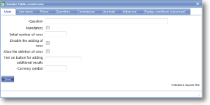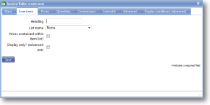|
Invoice tables are standard Table items with the functionality for entering price-related line items and calculating VAT and totals. Each line (row) within the table contains an initial column which contains an item name (this will usually be a drop-down list but does not have to be). Further columns contain the unit price, quantity and line item total. |
Main |
Main screen for creating/amending a Table | ||||||||
| *Question | This is the text “label” that is specifying the information that needs to be entered or the question to be answered. Although this is not necessarily a question in all cases, Question is used as the general term to cover the text shown next to an input field. The text should be as short as possible whilst still being self-explanatory. Over-long questions take up a lot of space on PDA screens with their restricted size, so try and make them concise. This text should be an aid to help guide the user through the screen. Any more explanatory text can be made available as “Auditor’s notes” or “Full question text”. | ||||||||
| Mandatory |
Tick this box if the question is mandatory and leave it blank if it is optional. This will depend on whether the answer to this question is critical to the data that is being collected, such as signature to confirm customer acceptance. |
||||||||
| Initial number of rows | Specifies how many rows are initially shown in the table. This can be used to save the user from having to repeatedly tap the ‘Add result’. By default there is 1 row in a table. | ||||||||
| Disable the adding of rows | Tick this box to prevent operators adding rows to the table. | ||||||||
| Allow the deletion of rows | Tick this box to enable the deletion of rows. | ||||||||
| Text on button for adding additional results | The wording on a button for additional rows. | ||||||||
| *Currency symbol | The currency symbol to be used when displaying monetary values on a report. | ||||||||
Line Items |
Create/amend columns in a Table. | ||||||||
| Heading |
Enter the text to be shown as the column heading. Bear in mind that this should be as abbreviated as possible due to the limited screen sizes on mobile devices. |
||||||||
| List name | Specify a standard list name in this field if you wish the user to select from a drop-down list rather than enter free text. See “List name” under the Drop-down list item for more details. | ||||||||
| Prices contained within list item | If the drop-down list in column 1 contains pricing information then tick this field – in that case the price will be automatically determined when the item is selected. | ||||||||
| Display only? (advanced use) | Specifies whether the display value associated with the list item can be edited (as, for example, in the case of price lists). | ||||||||
Prices |
|||||||||
| Heading |
Enter the text to be shown as the column heading. Bear in mind that this should be as abbreviated as possible due to the limited screen sizes on mobile devices. |
||||||||
| Prices include VAT? | If the unit price values (whether automatically looked up by the system or entered manually) include VAT then tick this box. | ||||||||
| *VAT rate | The rate to be used when calculating the VAT. | ||||||||
| Display only? (advanced use) |
Specifies whether the display value associated with the list item can be edited (as, for example, in the case of price lists). |
||||||||
| Unique name | Allocate a unique name to this column. | ||||||||
Quantities |
Quantity parameters for an Invoice table. | ||||||||
| Heading |
Enter the text to be shown as the column heading. Bear in mind that this should be as abbreviated as possible due to the limited screen sizes on mobile devices. |
||||||||
| Quantity list | If quantities should be entered using a drop-down list then choose the name of the list to be used. Alternatively, leave this selection empty in order to use a simple text entry box. | ||||||||
| Display only? (advanced use) |
Specifies whether the display value associated with the list item can be edited (as, for example, in the case of price lists). |
||||||||
Commission |
A Commission column must be created even if not required. | ||||||||
| Heading |
Enter the text to be shown as the column heading. Bear in mind that this should be as abbreviated as possible due to the limited screen sizes on mobile devices. |
||||||||
| Display only? (advanced use) |
Specifies whether the display value associated with the list item can be edited (as, for example, in the case of price lists). |
||||||||
Line total |
Line total parameters of an Invoice table. | ||||||||
| Heading | Enter the text to be shown as the column heading. Bear in mind that this should be as abbreviated as possible due to the limited screen sizes on mobile devices. | ||||||||
| Display only? (advanced use) |
Specifies whether the display value associated with the list item can be edited (as, for example, in the case of price lists). |
||||||||
Advanced |
Advanced features of an Invoice table. | ||||||||
| Pre-fill data from section (enter unique name of the section) | The data entered in the section named here (which is probably a repeating section) will be used to fill the invoice - see also items below. | ||||||||
| Unique name of product drop down | Enter the unique name used in the section named above for the data item that is to appear in the Product column of the invoice. | ||||||||
| Unique name of price drop down | Enter the unique name used in the section named above for the data item that is to appear in the Product column of the invoice. | ||||||||
| Unique name of quantity item | Enter the unique name used in the section named above for the data item that is to appear in the Product column of the invoice. | ||||||||
| Unique name of commission drop down | Enter the unique name used in the section named above for the data item that is to appear in the Product column of the invoice. | ||||||||
|
Auditor's notes |
If you wish to offer the end-user guidance and direction on how to answer a question then use the Auditor’s notes field. This allows you to input any necessary text expanding on the basic question. For the end-user, the auditor’s notes are available via the “right click” option on the device – tap and hold the stylus on the question text. |
||||||||
| For quantity-related rows, force quantities to be greater than 0 | Tick this box if the quantities in the table should be greater than zero - in other words a positive number must be entered. | ||||||||
|
Don't keep previous result when part of a document lifecycle |
Tick this box if you DO NOT wish data to be collected in this template item to be copied to any jobs created directly from the original form. This is useful for a repeated task (such as booking in/out a rental item or repeated delivery) where the data remains the same but a sign-off is required so this box may be ticked for Date, Surname and Signature. Please note that if a transformation option is applied to the newly created job, this setting may be over-ruled. |
||||||||
|
Full question (for report) |
The question text mentioned above should be framed in such a way as to indicate to the user the information that needs to be input. However, when this information is output on a report via the web site or a PDF additional wording may well be required. Use this field to phrase the original question in a way suitable for the report. |
||||||||
|
Search information for drop-down (advanced) |
This controls the screen showing search matches. Each line is a column. Within a line the values are:
Title;Item to show;Width
Item to show can be:
It is not possible to expand list item attributes within a list item. Here is a complex example: Reg;description;30% Make;XML:@asset_Make;20% Model;XML:@asset_Model;20% Serial;XML:@asset_SerialNo;20% A simple example would be: Item;description;100% |
||||||||
| Item flag |
Template item flags are used to apply display classes to template item in a consistent and efficient way. They are set up in a system list called Template item flags and might be given names such as Danger so the text appears in red, Disclaimer for smaller text, Long answer to give extra space to the answer. This means that changing the display class can be done in one place rather than on all template items. |
||||||||
| *Unique name |
A unique name must exist for everything in a magic5 template. It is so important that magic5 pre-fills the prompt with a non-meaningful name which it will use by default. This does not need to be changed. However, if the data associated with the unique name is to be used elsewhere (for example as part of a calculation, imported or exported, or carried over to a new job), it is helpful to use a meaningful name (such as RefNo, QuantityOrdered, ItemTotal, ContactName, ReasonForReferral) and this meaningful name must be entered before the template is used with real data. If the unique name is changed at a later date, existing data will not be lost but it may no longer be accessible by magic5, in which case it cannot be displayed, used in calculations or exported. It is therefore recommended that this is done only as a last resort and that the original template is duplicated before changes are made - this means that existing data can still be retrieved if necessary. If in any doubt, please contact magic5 support for the best way to deal with this. |
||||||||
|
|||||||||










